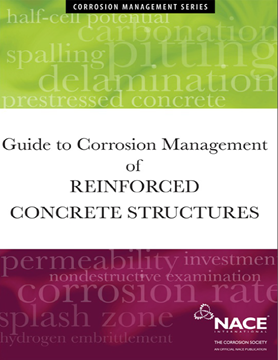Search
Products tagged with 'steel reinforcement'
View as
Sort by
Display
per page
51316-7235-Detecting Inhibitor Migration Depth in Topically-Treated Concrete Using DART-MS
Product Number:
51316-7235-SG
ISBN:
7235 2016 CP
Publication Date:
2016
$20.00
51318-10808-Cymbopogon citratus and Na2Cr2O7 Effects on Concrete Steel-rebar Corrosion in Industrial/Microbial Simulating-Environment
Product Number:
51318-10808-SG
Publication Date:
2018
$20.00
51318-11079-Assessment of Aging Mechanisms for Concrete Exposed to Outdoor and Below-Grade Environments in Spent
Product Number:
51318-11079-SG
Publication Date:
2018
$20.00
A Two-Stage Cathodic Protection System Combining ICCP Components with Long-Term Galvanic Anode Steel Reinforcement Protection
Product Number:
51323-18868-SG
Publication Date:
2023
$20.00
CorrCompilations: Concrete (E-book)
Product Number:
37606-E
ISBN:
9781575903194
Publication Date:
2016
$130.00
Guide to Corrosion Management of Reinforced Concrete Structures
Product Number:
24246-SG
ISBN:
1-57590-244-3
Publication Date:
2011
$120.00
Long-Term Monitoring Of Galvanic Anodes Provides Data To Predict Performance And Perform Intelligent Design Of Galvanic Corrosion Control Systems For Reinforced Concrete Structures
Product Number:
51321-16712-SG
Publication Date:
2021
$20.00
NACE Publication 01104-2004, Electrochemical Realkalization of Steel-Reinforced Concrete—A State-of-the-Art Report
Product Number:
24223-HD2004
ISBN:
01104
Publication Date:
2004
$179.00
NACE Publication 01104-2020, Electrochemical Realkalization of Steel-Reinforced Concrete—A State-of-the-Art Report
Product Number:
24223-SG
ISBN:
01104
Publication Date:
2020
$109.00
NACE SP0107-2017, “Electrochemical Realkalization and Chloride Extraction for Reinforced Concrete”
Product Number:
21113-SG
ISBN:
1-57590-210-9
Publication Date:
2017
$179.00
NACE TM0294-2016-SG, “Testing of Embeddable Impressed Current Anodes for Use in Cathodic Protection of Atmospherically Exposed Steel-Reinforced Concrete”
Product Number:
21225-SG
ISBN:
1-57590-133-1
Publication Date:
2016
$109.00
SP0290-2019 Impressed Current Cathodic Protection of Reinforcing Steel in Atmospherically Exposed Concrete Structures
Product Number:
21043-2019
ISBN:
1-57590-103-X
Publication Date:
2019
$109.00
- 1
- 2












